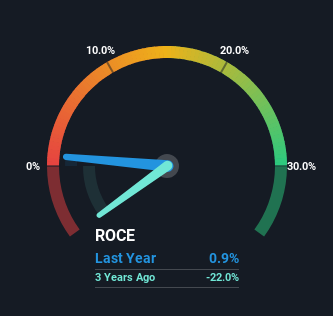D-BOX Technologies' (TSE:DBO) Returns On Capital Are Heading Higher
To find a multi-bagger stock, what are the underlying trends we should look for in a business? Ideally, a business will show two trends; firstly a growing return on capital employed (ROCE) and secondly, an increasing amount of capital employed. Put simply, these types of businesses are compounding machines, meaning they are continually reinvesting their earnings at ever-higher rates of return. With that in mind, we've noticed some promising trends at D-BOX Technologies (TSE:DBO) so let's look a bit deeper.
What Is Return On Capital Employed (ROCE)?
Just to clarify if you're unsure, ROCE is a metric for evaluating how much pre-tax income (in percentage terms) a company earns on the capital invested in its business. Analysts use this formula to calculate it for D-BOX Technologies:
Return on Capital Employed = Earnings Before Interest and Tax (EBIT) ÷ (Total Assets - Current Liabilities)
0.0086 = CA$119k ÷ (CA$27m - CA$13m) (Based on the trailing twelve months to June 2023).
Therefore, D-BOX Technologies has an ROCE of 0.9%. Ultimately, that's a low return and it under-performs the Consumer Durables industry average of 15%.
Check out our latest analysis for D-BOX Technologies
Historical performance is a great place to start when researching a stock so above you can see the gauge for D-BOX Technologies' ROCE against it's prior returns. If you want to delve into the historical earnings, revenue and cash flow of D-BOX Technologies, check out these free graphs here.
What The Trend Of ROCE Can Tell Us
We're delighted to see that D-BOX Technologies is reaping rewards from its investments and has now broken into profitability. Historically the company was generating losses but as we can see from the latest figures referenced above, they're now earning 0.9% on their capital employed. In regards to capital employed, D-BOX Technologies is using 50% less capital than it was five years ago, which on the surface, can indicate that the business has become more efficient at generating these returns. The reduction could indicate that the company is selling some assets, and considering returns are up, they appear to be selling the right ones.
For the record though, there was a noticeable increase in the company's current liabilities over the period, so we would attribute some of the ROCE growth to that. Essentially the business now has suppliers or short-term creditors funding about 48% of its operations, which isn't ideal. And with current liabilities at those levels, that's pretty high.
What We Can Learn From D-BOX Technologies' ROCE
In summary, it's great to see that D-BOX Technologies has been able to turn things around and earn higher returns on lower amounts of capital. And since the stock has fallen 59% over the last five years, there might be an opportunity here. That being the case, research into the company's current valuation metrics and future prospects seems fitting.
Like most companies, D-BOX Technologies does come with some risks, and we've found 1 warning sign that you should be aware of.
While D-BOX Technologies may not currently earn the highest returns, we've compiled a list of companies that currently earn more than 25% return on equity. Check out this free list here.
Have feedback on this article? Concerned about the content? Get in touch with us directly. Alternatively, email editorial-team (at) simplywallst.com.
This article by Simply Wall St is general in nature. We provide commentary based on historical data and analyst forecasts only using an unbiased methodology and our articles are not intended to be financial advice. It does not constitute a recommendation to buy or sell any stock, and does not take account of your objectives, or your financial situation. We aim to bring you long-term focused analysis driven by fundamental data. Note that our analysis may not factor in the latest price-sensitive company announcements or qualitative material. Simply Wall St has no position in any stocks mentioned.

